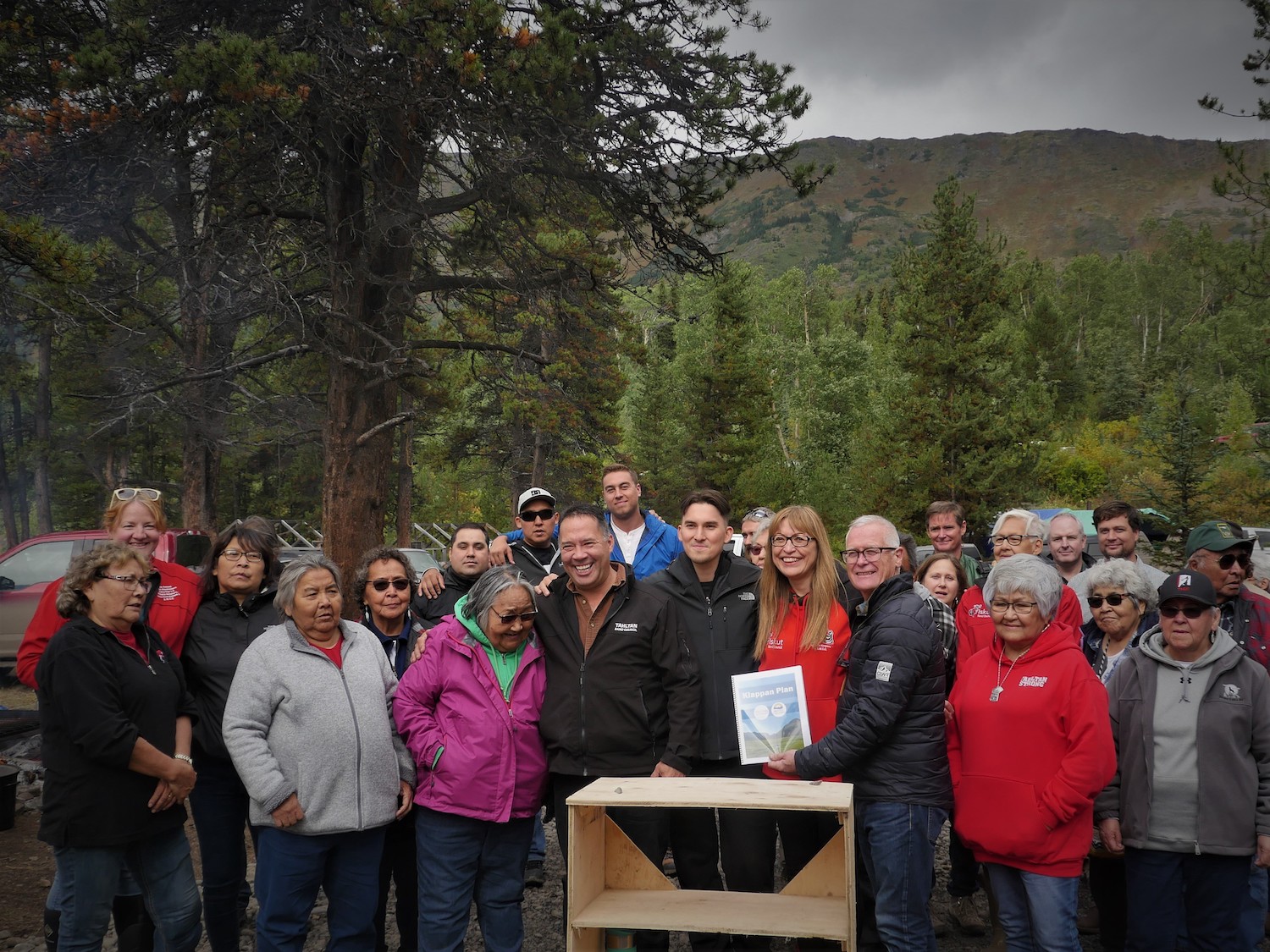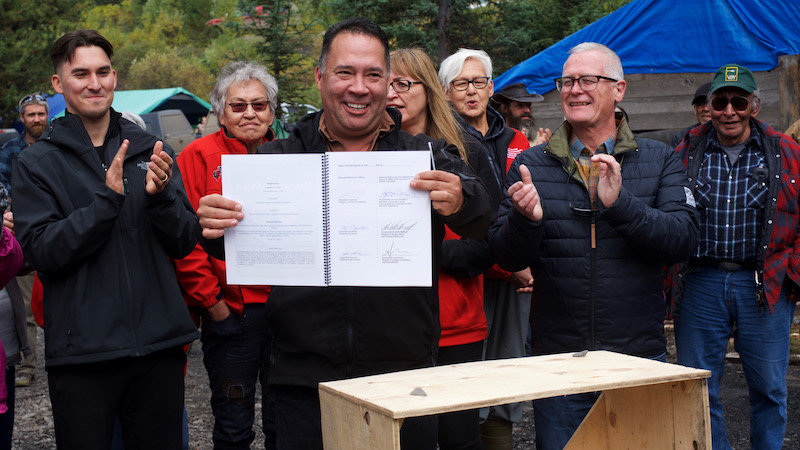“Protect our land!”
The cry rings out across Kawdy Cho camp, eliciting laughter as dignitaries, their pens poised, gather around a plywood podium to ensure — at least for a while — protection of the Sacred Headwaters.
The laughter signals the sense of relief and hope that the signing of the Klappan Plan by the B.C. government and the Tahltan First Nation is a step toward giving the nation greater control over its traditional territory after 15 years of disputes over resource development in the area, the source of the Skeena, Nass and Stikine rivers.
Last week, Doug Donaldson, the BC minister of forests and natural resources, Iskut Band Chief Marie Quock, Tahltan Central Government president Chad Day and Tahltan Band Chief Rick McLean signed the agreement in a ceremony held at a camp 100 kilometres southeast of Iskut, deep in the heart of Tahltan territory. The camp, at the base of Klappan Mountain, is used to teach Tahltan youth about their culture.
McLean, the last to sign, smiles broadly as he lifts the document for all to see. Applause erupts from the 50 or so people gathered — Tahltan community members, government bureaucrats, environmental advocates and mining industry representatives.
James Bourquin, who has lived in Iskut for decades and raised his family here, says the enthusiasm is justified.
“When you’re all on the same page, it’s a time for celebration,” he says. “Our job now is to pass on our interests to our kids.”
The agreement follows years of battles over resource development in the region. As the leaders pose for photos, they share the spotlight with Tahltan elders, the Klabona Keepers, who fought to protect the area from mining and fracking. Some were taken away in handcuffs during 2005 road blockades.
Some of the Keepers, Quock notes later, did not live long enough to see the agreement signed.
Finding common ground has been challenging since conflict erupted over the future of the Sacred Headwaters 15 years ago. As well as being the source of three of B.C.’s major salmon rivers, the Klappan also contains rich coal deposits. Industry’s interest in the region dates back to the 1980s, when Gulf Canada conducted exploration work here.
In 2004, Fortune Minerals acquired the Klappan Mountain coal licences; the same year, the province granted a tenure to Royal Dutch Shell to drill for coalbed methane in the culturally significant area.
Community members who wanted to protect the Klappan were outraged, and the community was divided between those favouring conservation and those who welcomed the economic development.
In 2008, after the conflict had attracted international media attention, the provincial government imposed a two-year moratorium on coalbed methane development in the headwaters, which was later extended until 2012. Later that year, Shell relinquished its tenure.
The issue flared again in March 2013 when Fortune Minerals was granted a permit to continue coal exploration in the Klappan, leading to more road blockades that August. Talks between the province and Tahltan leadership began in 2013. In 2014 the Klappan Technical Report laid the groundwork for the Klappan Plan signed last week.

The plan divides the region. Zone A, the Sacred Headwaters, is about 287,000 hectares, or 46 per cent of the area covered by the agreement. The area surrounds Klappan Mountain and has “significant ancient, historic, current, and future uses, sites, gathering/harvesting areas, and trails,” the plan says.
“The zone is considered one of the core areas of cultural importance and a seasonally important ‘breadbasket’ to meet sustenance needs for the Tahltan Nation.”
The management objective within that zone is, according to the plan, to protect “the core of the Klappan, including the Sacred Headwaters area, from Industrial Activity for an initial proposed minimum period of 20 years.”
But existing coal licences still leave question marks about the extent of the protection.
In 2015, the province and Fortune Minerals agreed on a Coal Licence Purchase Agreement. The government agreed to buy Fortune’s licences for $18.3 million, but gave the corporation a 10-year option “to re-purchase the licences at the original price after the Province and the Tahltan Nation have developed a shared vision for the Klappan.”
That — and the 20-year limit on the Klappan Plan — leave the area vulnerable to mining.
The Sacred Headwaters is buffered by two other zones. In Zone B, about eight per cent of the area, industry is “generally acceptable,” although “proponents are encouraged to build and strengthen their relationship with Tahltan, and engage in discussions on the proposed project.”
In Zone C, almost half of the total area, “economic development is viewed as appropriate and acceptable.” It’s intended to provide space for “mutual interest in responsible economic development.”
Some Iskut elders say the goal remains permanent protection for the entire area. In a letter last year in response to the plan, 16 elders said they see it as “a building block to achieve long-term conservation of our unceded, traditional territories in the Klappan.”
“We want to emphasize that this cannot be interpreted as wholehearted support,” they wrote. “There is much work yet to be done, many fundamental discussions to be had and we don’t want those to cease once the implementation plan has been approved.”
A Klappan Decision-Making and Management Board, composed of provincial and Tahltan representatives, has been assembled to implement the plan. Their first task will be addressing the coal licences.
The agreement’s signing comes just 10 days after the federal government announced the Tahltan Central Government would receive almost $4 million for land-use planning to establish Indigenous protected areas within their territory.
Before the signing, people from all sides in the past disputes gathered under the late-August sun to talk, laugh and dine on caribou stew and porcupine meat.
In the Iskut community hall that evening, Donaldson tells those gathered that the plan is “a great beginning.”
Quock agrees.
“The work isn’t done. It’s actually just starting. There’s a lot of work we still need to do,” she says. “In 2005, our community got ripped apart when Shell was wanting to go in there. That was one of the toughest times for us. That’s when I first became the chief. That was very, very difficult, finding the balance between the people who wanted to work, the people who wanted to protect the land.”
“I knew in my heart all the time that the Klappan is a very special place and we do need to protect it. There are some special places in the world that need to be protected — that’s one of them.” ![]()
















Tyee Commenting Guidelines
Comments that violate guidelines risk being deleted, and violations may result in a temporary or permanent user ban. Maintain the spirit of good conversation to stay in the discussion.
*Please note The Tyee is not a forum for spreading misinformation about COVID-19, denying its existence or minimizing its risk to public health.
Do:
Do not: